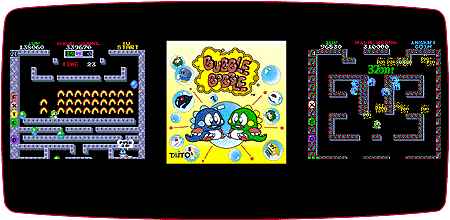Bubble Bobble series

Retro Coin Op Synopsis
Deep within “the cave of monsters,” two bubble-blowing dinosaurs undertook a fantastic journey to rescue their lady loves from a gigantic beast called Grumple Grommit. Taito’s Bubble Bobble may not have had the most airtight storyline, but this wildly popular platform game compensated with cute cartoon graphics, innovative gameplay and 100 levels of addictive fun.
In each level of Bubble Bobble, tiny dinos Bub (the green one) and Bob (the blue one) ran and jumped around a screen littered with dangerous (but still adorable) monsters. Their only defense? Bright, shiny bubbles. Both Bub and Bob were expert bubble blowers, and if they were close enough to their foes, the baddies would become trapped inside, floating helplessly around the screen. Once the bad guys were trapped, our two dino heroes could pop the bubbles with their spiky bodies, turning their enemies into tasty, bonus-awarding fruits. Once a screen was cleared, Bub and Bob moved on to a new adventure on the next one.
In concept, Bubble Bobble seemed simple, but its enduring popularity was in the details. The game was filled with little tricks and touches, including a wide range of power-up items. Certain bubbles held special powers—waves of water, bolts of lightning, raining fire, etc.—that would be unleashed when Bub or Bob popped them. Other bubbles contained the letters to spell E-X-T-E-N-D, which would move the dinos on to the next level and award a bonus life when the word was completed. Still other objects, such as clocks, potions, candies and shoes, gave temporary benefits like increased speed, invincibility, fire breath or frozen enemies.
Bubble Bobble’s gameplay was also designed with a great deal of imagination. The bubbles acted like real bubbles, bobbing along unseen air currents, congregating in certain spots on the screen. Popping a bubble would set off a chain reaction, exploding every other bubble in its wake for high combo scores. Players could even hop on top of the fragile bubbles if they executed it right. There were plenty of new tricks to try and new ideas to explore, but Bubble Bobble didn’t tolerate dawdlers. If players took too long on any level, a “Hurry Up!” message would flash, and the dreaded ghostly whale Baron von Blubba would hunt them down until they popped the rest of their enemies.
Making Bubble Bobble even more attractive to arcade gamers was its two-player join-in system. Either Bub or Bob could choose to play solo, but another dino could enter the game at any time, lending a helping mouth to his buddy’s journey. This cooperative feature helped make Bubble Bobble one of the hottest arcade hits of 1986, another step on the road back from the 1984 video game market crash.
Taito released several sequels and variations of the Bubble Bobble franchise over the years, both in the arcades and on the many home systems of the day. Rainbow Islands: The Story of Bubble Bobble 2 was the first arcade sequel, giving the now-human Bub and Bob the power to fire rainbows at their enemies. The two were charged with saving Rainbow Island, a task that forced them to move through several Bubble Bobble-like levels, facing boss enemies along the way. 1988's Bubble Bobble 3 (a.k.a. Parasol Stars) continued Bub and Bob's human form adventures, this time armed with powerful parasols.
Bubble Symphony arrived in arcades in 1994, bringing the franchise back to its bubbly roots. Bub and Bob were now joined by two more dinosaurs, each with varying abilities. Once more, the dinos had to blow bubbles to clear enemies from hundreds of levels. Even more adventures awaited in Bubble Memories: The Story of Bubble Bobble III, a 1995 game. In this installment, the dinosaurs and their enemies could change sizes, forcing Bub and Bob to blow bubbles both big and small.
In addition to the true Bubble Bobble sequels, the game also spawned the puzzle game series Bust-a-Move (a.k.a. Puzzle Bobble). Bub and Bob seemed to pop up everywhere Taito went, giving the company one of its biggest hits since Space Invaders and putting two more cute faces onto the arcade industry.
See also: Bust-a-Move series (arcade games)
Arcade Machine Release History
1986 - Bubble Bobble1987 - Rainbow Islands - The Story of Bubble Bobble 2
1988 - Bubble Bobble 3 ( Parasol Stars )
1994 - Bubble Symphony
1995 - Bubble Memories - The Story of Bubble Bobble III
